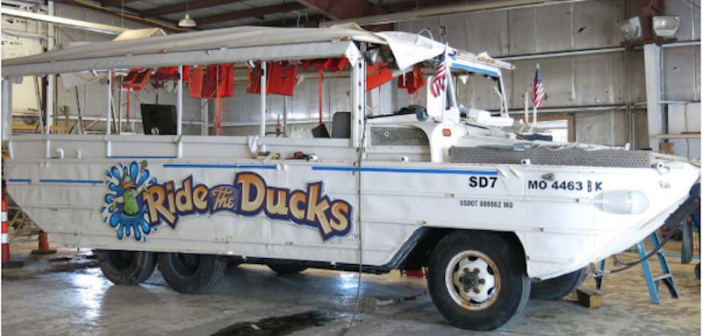The National Transportation Safety Board (NTSB) faulted the operator of the duck boat and the Coast Guard for the sinking that killed 17 people near Branson, Mo., in 2018 — the deadliest duck boat accident ever.
Ripley Entertainment Inc. continued operating the water part of its tour after a severe thunderstorm warning had been issued for Table Rock Lake, the NTSB said at a virtual meeting Tuesday. And the Coast Guard contributed to the accident by not requiring sufficient reserve buoyancy and or addressing emergency evacuation issues caused by the boat’s fixed canopy.
The agency recommended the owner provide specific guidelines for severe weather, make sure spring-loaded forward hatches can be secured if water is coming in and re-evaluate life-jacket instructions for boats with fixed canopies.
It also wants the Coast Guard to require tightening forward hatches, revise its Navigation and Vessel Inspection Circular (NVIC) 1-01 issued after another fatal duck boat accident and review and possibly require additional weather training for mariners.
The 33'x8'x5' Stretch Duck 7, built in 1944, was carrying 29 passengers and two crewmembers for what was usually a 20-minute ride on the lake July 19 when a strong thunderstorm swept through with wind gusts up to 73 mph and 3'-5' waves.
The captain did not have any weather-monitoring tools onboard, and “his visual assessment of the lake was limited,” Brian Young, the investigator in charge told the board. “The manager on duty and the people at the dock had the most pertinent information” to decide what to do.
NTSB chairman Robert L. Sumwalt wanted to know why the captain wasn’t mentioned in the probable cause conclusions. Young said they didn’t have enough information because they couldn’t talk with him. The Department of Justice is conducting a criminal investigation.
“You can’t know what you don’t know,” Sumwalt said; when the boat was launched “it was glassy smooth on that lake.”
A federal grand jury indicted Capt. Kenneth Scott McKee, general manager Curtis Lanham and operations supervisor Charles Baltzell on charges of misconduct and neglect. All have pleaded not guilty.
The indictment alleges Lanham failed to establish training requirements for monitoring the weather or require adequate staffing during the tours and didn’t let Baltzell have access to his Ripley e-mail account, which got weather alerts from a monitoring service. Baltzell failed to monitor and assess the weather and let the vessel enter the water when lightning was in the area, the indictment charges.
Both were accused of letting McKee operate the vessel in violation of the Coast Guard’s Certificate of Inspection (COI) that limits operating conditions to winds not to exceed 35 mph and wave heights of 2' or less.
The NTSB issued a number of duck boat safety recommendations to the Coast Guard after 13 people died in 1999 in the duck boat Miss Majestic accident in Hot Springs, Ark. They wanted the boats to have enough reserve buoyancy to float even if flooded. If not, they should install new canopies that don’t restrict escape. And if canopies have been removed and reserve buoyancy is inadequate, passengers should be required to don life jackets before leaving the dock.
In response, the Coast Guard said it issued NVIC 1-01 “which laid out an equivalent level of safety” to other Subchapter T vessels for items such as modification to the side curtains.
“Lives could have been saved, and the Stretch Duck 7 accident could have been prevented had previously issued safety recommendations been implemented,” Sumwalt said after the NTSB late last year reiterated its call for the Coast Guard to step up its DUKW safety requirements.
Another duck boat on the lake was able to make it to safety because it had more buoyancy, higher freeboard and a solid steel hatch cover held with fasteners, the board was told.
The Coast Guard last week recommended duck boat operators voluntarily remove canopies, side curtains and overhead framing to make escapes easier.
The issue of life jackets presented a dilemma because donning them in a closed compartment could make it harder to get out.
On one hand, passengers are told to put on a life jacket, but on the other hand, they have a significant chance of being trapped, said board member Bruce Landsberg. “So we have a Catch-22 here” — very difficult circumstances with conflicting guidance.
Ripley said in a statement: “We will be reviewing the National Transportation Safety Board’s report as soon as it is available. Branson Ride The Ducks fully cooperated with the NTSB’s investigation into the accident that occurred in July of 2018. We remain dedicated to working with the community of Branson, and continuing our support of all those who were impacted by the accident.”
An abstract of the NTSB’s final report is available.



.JPG.small.400x400.jpg)

